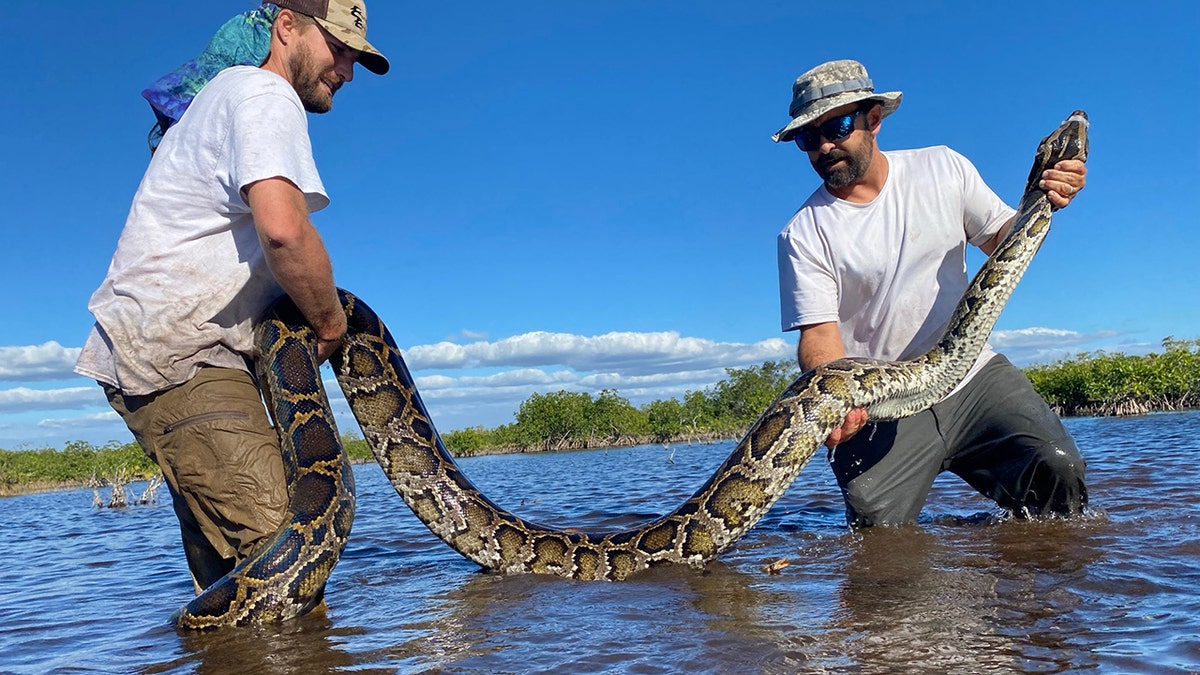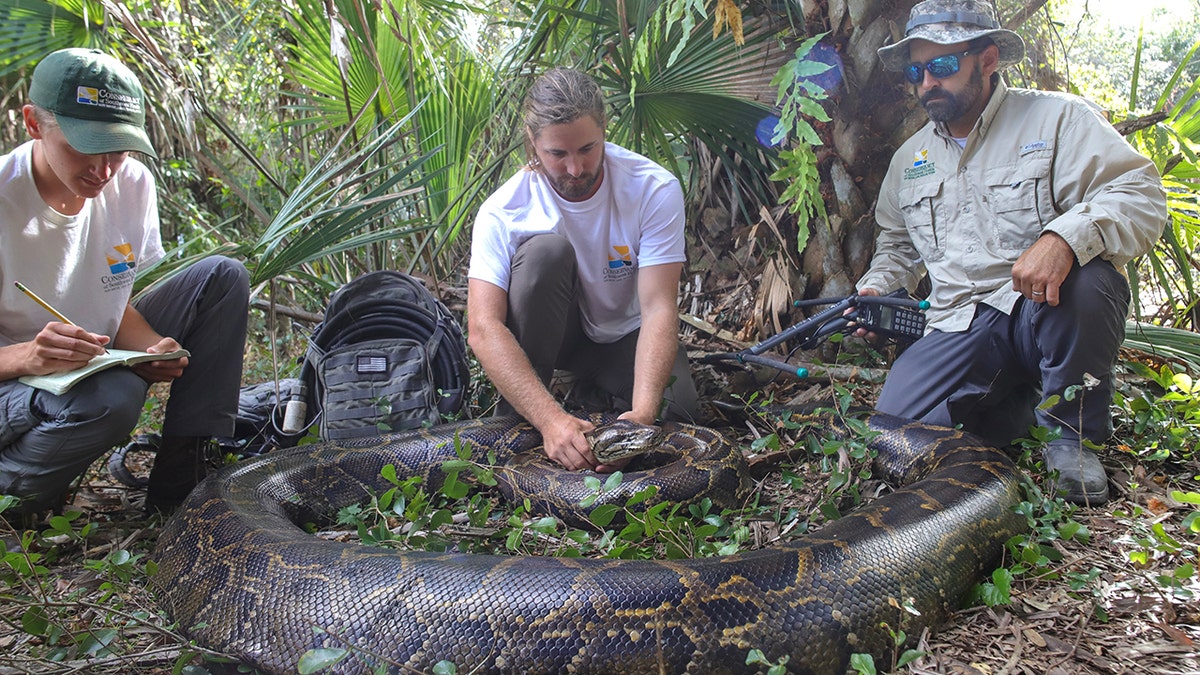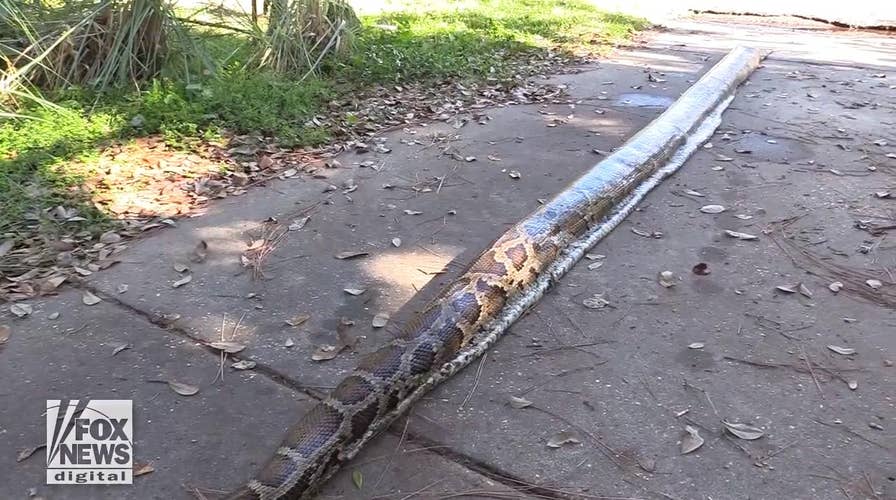Florida man captures record 18-foot Burmese python, the largest in the state
The largest Burmese python found in Florida has been caught.
The growing Burmese python population in South Florida and into Everglades National Park and its many unknowns have led scientists to the realization that the eradication of the invasive species in the southern portion of the state is likely impossible.
In a research paper released earlier this year, the U.S. Geological Survey (USGS) said Burmese pythons in southern Florida represent "one of the most intractable" management issues in the world when it comes to invasive species.

A Burmese python, a nonnative species in the area, is captured in south Florida. (FWC photo by Andy Wraithmell)
Although Burmese pythons were detected in the Everglades as early as 1979, it was not until the late 1990s and early 2000s that the confirmation of a reproduction population prompted the snake to be recognized as an established invasive species in the national park.
GIANT BURMESE PYTHON IN FLORIDA EVERGLADES SPOTTED CROSSING ROAD IN WILD VIDEO
The issue has spread into Broward and Palm Beach counties and continues to move northward to areas like Lake Okeechobee and Fort Myers, and it all started with just a few snakes introduced into the wild from the exotic pet trade.
The new paper looks at findings from over 250 research programs and touches on ways the invasion could be slowed, acknowledging that little is known when it comes to how often pythons reproduce in their new environment, how long they live, and how big the population has grown.
"Annual survival has not been well characterized for Burmese pythons, in part because requisite sample sizes and study durations for telemetry-based estimations are logistically and financially challenging," the paper noted from 2006. "However, survivorship is presumably high because adult Burmese pythons in southern Florida reach sizes that are too large for most predators to kill them."

Biologists Ian Easterling, Ian Bartoszek with 14ft female Burmese python captured in mangrove habitat of southwestern Florida while tracking a male scout snake. (Conservancy of Southwest Florida)
The largest python ever recorded in Florida was nearly 19 feet long and weight 214 pounds as it carried 122 eggs.
SOUTH FLORIDA RESEARCHERS USE GPS-FITTED POSSUMS AND RACCOONS TO CAPTURE INVASIVE PYTHONS: REPORTS
Pythons in Florida typically lay, on average, a clutch size of between 11 and 84 eggs, though larger snakes have been reported to carry as many as 79-87 eggs.
Researchers in Florida began outfitting small mammals like raccoons and possums with GPS tracking devices to help track the locations and movements of pythons.

Biologists Ian Bartoszek (right) and Ian Easterling (center) with intern Kyle Findley (left) and a 17.7-foot, 215-pound female Burmese python captured by tracking a male scout snake in Picayune Strand State Forest in December 2021. (Conservancy of Southwest Florida)
After five months of research, there was a breakthrough when one of the possum collars stopped moving and then started moving again a few hours later. What researchers found was the lack of movement triggered a mortality signal, but when it started moving again, they realized the small mammal had been eaten by a snake.
FLORIDA MAN CAPTURES 28 BURMESE PYTHONS TO WIN TOP PRIZE IN STATE'S ANNUAL CHALLENGE
It took about a month for researchers to find the tracker as the snake moved in and out of Key Largo’s labyrinth of caves, and when they did, they found a 12-foot-long, 66-pound female python full of egg follicles.
The state also holds an annual culling in October called the 2022 Florida Python Challenge. Last year, 231 snakes were killed during the challenge.
But methods like the annual challenge will hardly put a dent in the exploding population of Burmese pythons in southern Florida.
CLICK HERE TO GET THE FOX NEWS APP
"Although a wide variety of techniques have been employed to catch pythons across southern Florida, many of these tools have not been evaluated rigorously, largely because of difficulty detecting pythons," the paper concluded. "Overall eradication of pythons in southern Florida is likely impossible. Suppression of the python population, even at local scales, will require strategic coordination of researchers, land managers, funding, public outreach, implementation of several different complimentary tools, and rigorous evaluation of these tools."























